Jan 13, 2020 | Nancy’s Holy Land Trip 2019-20
So if you remember way back to Tel Megiddo, the word “Tel” means that it’s an area that has been built up, one civilization on top of another. In the case of Megiddo, it was 26 layers, one on top of another. Here at Tel Dan, it is two. The original buildings and town here were built by the pagan Canaanites. Later, the Israelite tribe of Dan came in and conquested it and built the city of Dan on top of the city foundations of the Canaanite town of Laish. The tribe of Dan was not really happy with their allotment of the Promised Land, and sent their spies out to find a new spot. They found this spot, including one of the three headwaters of the Jordan River, and decided they’d go to war with the Canaanites for it, and won. The ruins we saw here were from the time of David and Solomon, for the brief years that there was peace and prosperity while they were ruling the Israelites. But let’s start at the beginning of our hike.
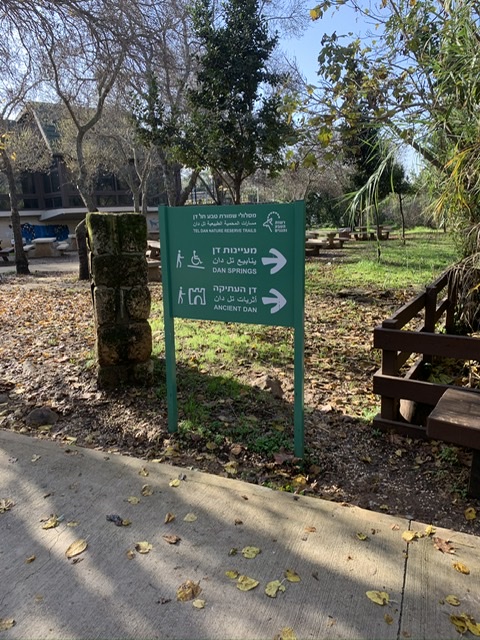
There is a visitor center, like most national parks in the states, with a gift shop and rest rooms, etc. So we start our hike and immediately cross one of the tributaries of the Jordan. Eitan assures us that this is the highest he has seen the water flowing, because it has been raining the last few days. He said the “sponge” that is Mt Hermon is full, causing the spring here to gush. So the first thing we see is this.
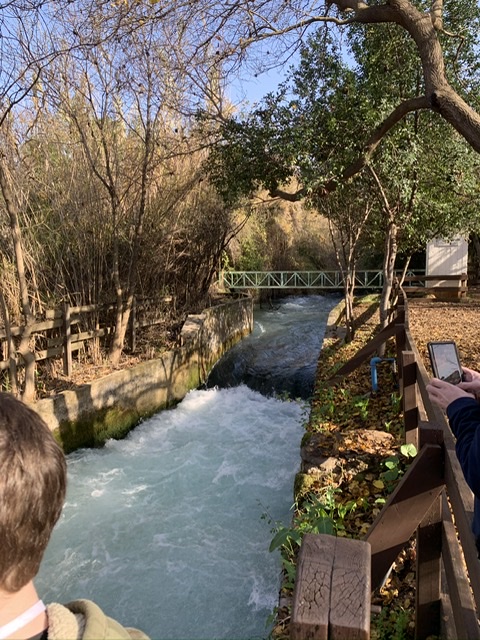
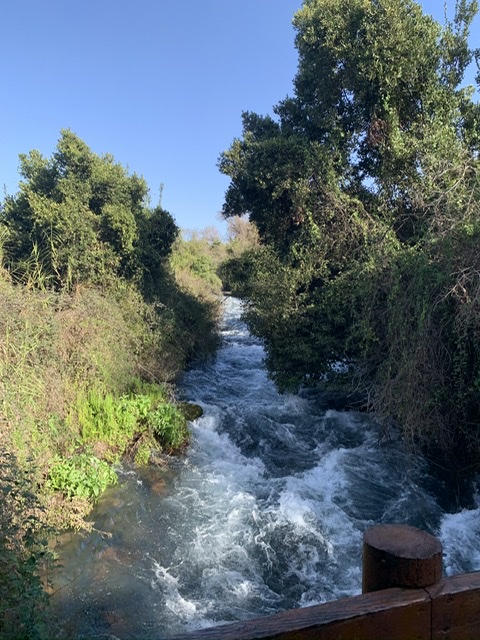
We hike for a little while, weaving around the water and other tiny streams that are adding into the river from the mountain. Here is the headwaters.
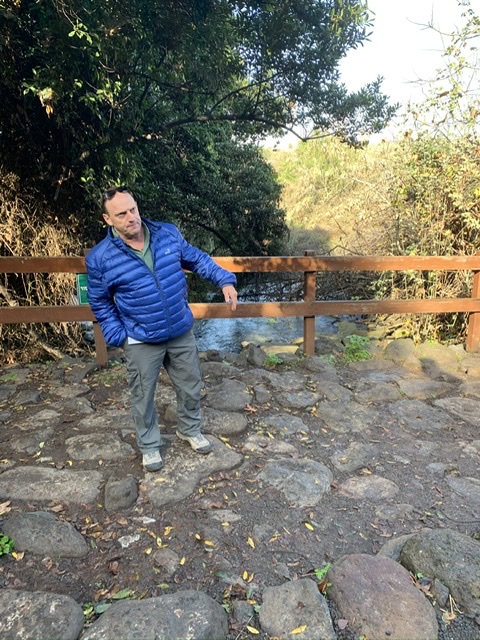
We have a devotional here before moving along to the old ruins.
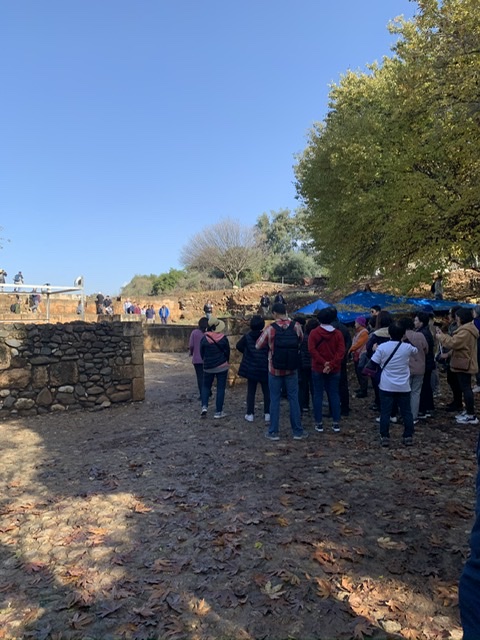
There is the old Canaanite ruins and the stuff the tribe of Dan built on top. Here is the temple area, and the place where sacrifices were made.
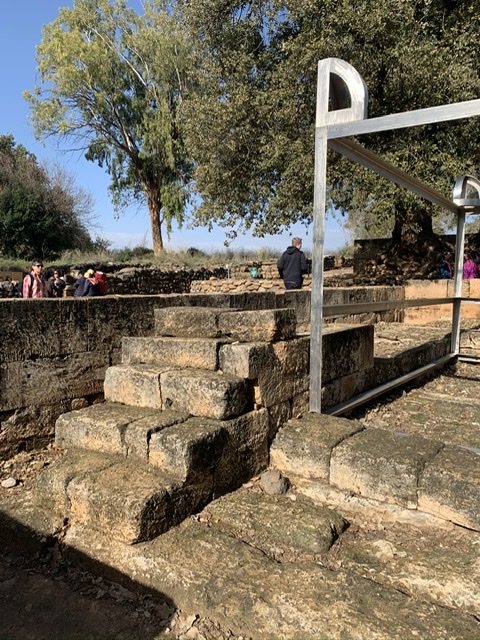
Steps up to the altar, which is not a part of the Levitical code. God said not to make steps up to meet Him. This is called a cultic site because of the pagan nature of this altar area.
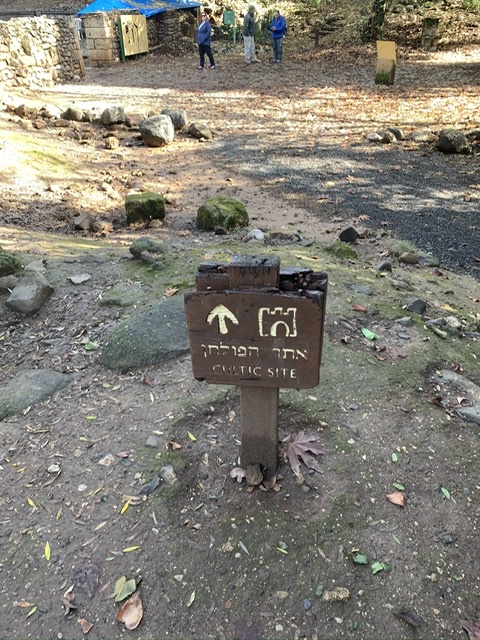
And here is a video of pastor explaining it that does so much better than I could explain.
E82E89A7-E15B-4311-A537-012F000FF2B4
I got feedback that videos inserted like this are playable, so hopefully that is the case for everyone. Here is the Temple Mount from the time of Solomon and David as well.
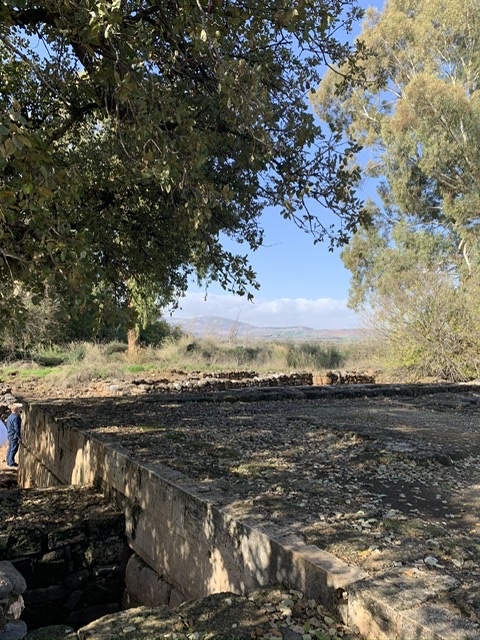
I found it interesting that the bricks for this temple in Tel Dan were so similar to the bricks used at the temple in Jerusalem.
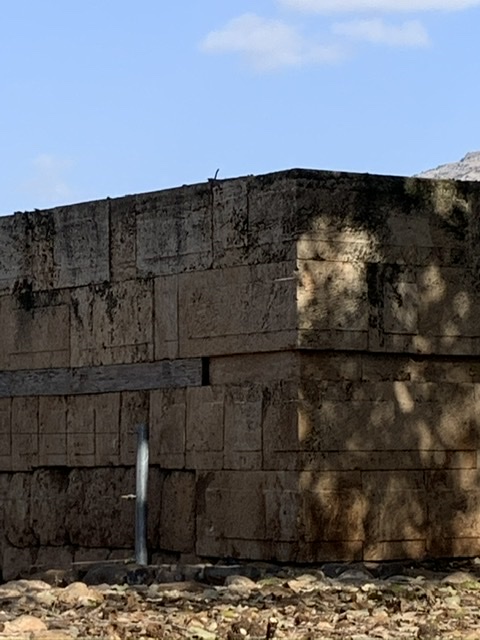
Here are some more of the pagan bricks. That’s a long time ago, impressive to see ruins that old.
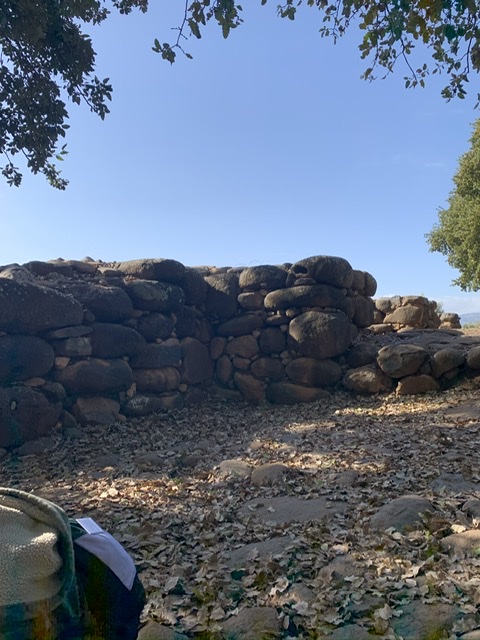
We walked further through the city streets, sort of, and up to the city gate.
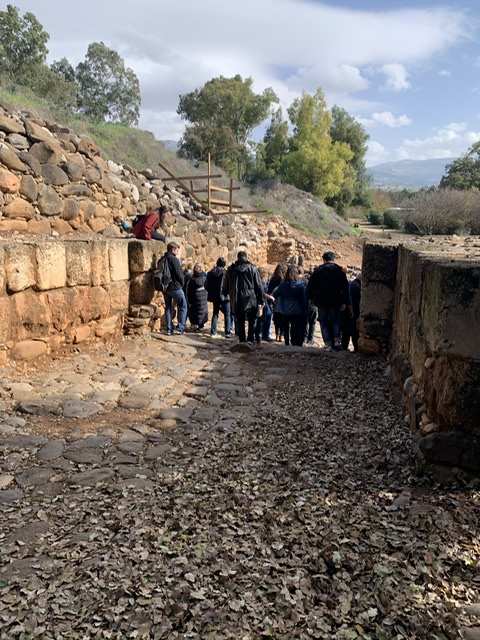
Also near the city gate is where the city leader or judge appointed by the city leader would sit and settle disputes. This person would sit on something similar to a Moses seat, like we saw in Chorazin.
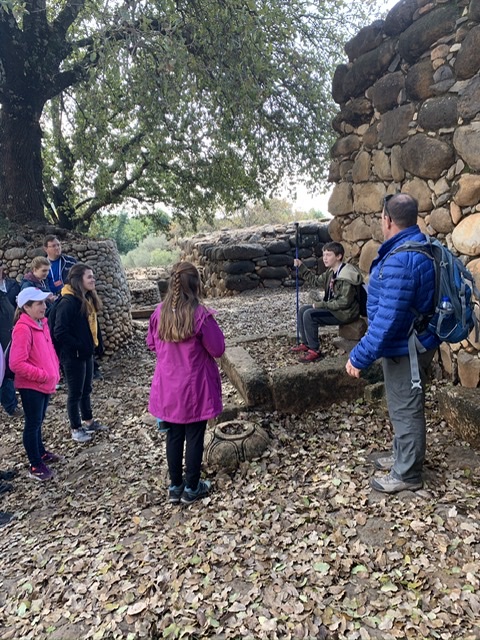
One of our crew was showing how it’s done. I also found it interesting that cities with walls around would have 2 or more sets of gates, and the second gate would involve making a left turn to get to it. The reason is so that invaders with swords and shields were predominately right handed. So what does that mean? Soldiers attacking the town would come into the first gate with their swords in their right hands and shields in their left. As they make a left turn to attack the second gate, their right unshielded side is exposed to attackers on the wall inside the city. Pretty brilliant.
We exit the city gate and walk over to a place called the Abraham gate. We round a corner and see this model.
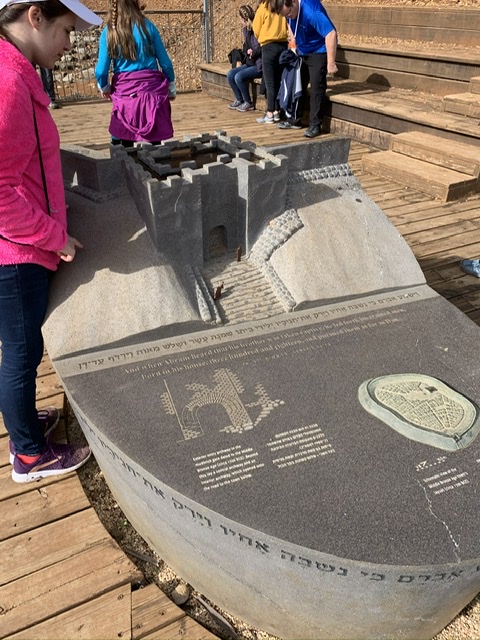
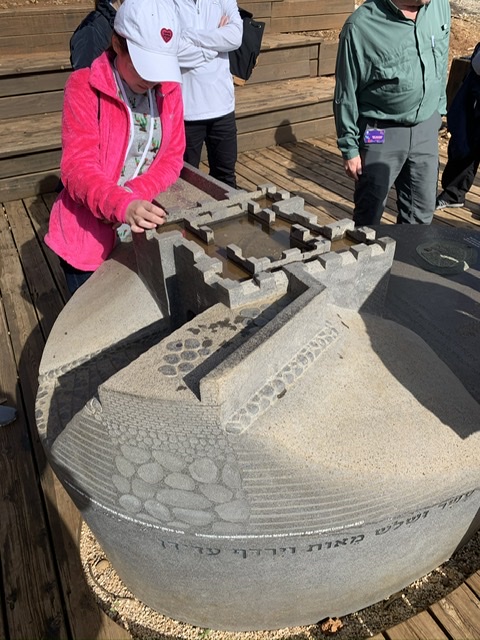
Here’s the backside of the model. This is an area that has very recently been found, like within the last 10 years, maybe even 5, I’d need to ask pastor for sure. Above the model, we look up and see this.
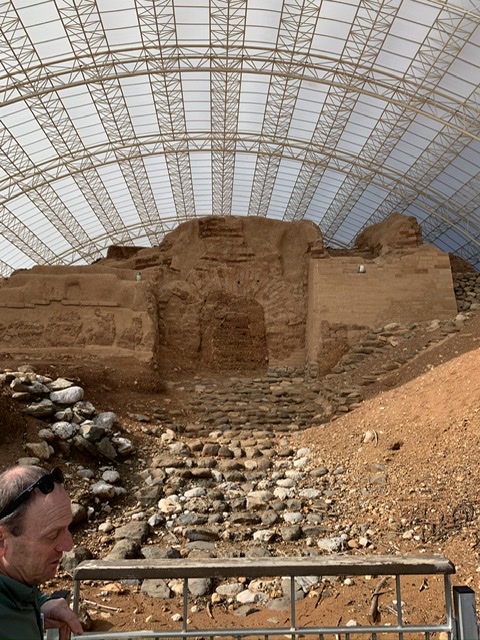
WHOA. This is steps up to an ancient city entrance here at Dan. The archaeologists did excavate this which is how they got the model. Then they filled it back in so it would be preserved and not collapse, as it is mud brick and they are fragile. They built this structure over it so the rain wouldn’t erode it. The hills nearby, just north of where we were standing, is the place thought to be where God cut covenant with Abram. After that, Abram would have entered then Laish through this gate. That is some old archaeological site stuff going on there. Scripture talks about Abram going into Dan. But how could that be? It wasn’t Dan yet. It wouldn’t have been Dan until much later, after the Israelites, Abraham’s descendants, took this area over. See the problem? Pastor gave a talk about how this could have happened in scripture. I did record his talk, but it is an 11 minute video and too large to include on the blog.
What an incredible site. Old. Old Testament old. The next place we went is also old. Next up is Caesarea Phillipi.
Jan 13, 2020 | Nancy’s Holy Land Trip 2019-20
Day 10, again, was a bit slower paced, and we spent longer at our two destinations with more hiking involved. Thankfully, I was feeling a bit better this day because we did some walking. I think I ended up with north of 14.000 steps. These two sites were worth the effort though, as everything was. Today we hiked Tel Dan and Caesarea Phillipi. Very cool. Tonight was our first night staying at the kibbutz as well, which was very nice.
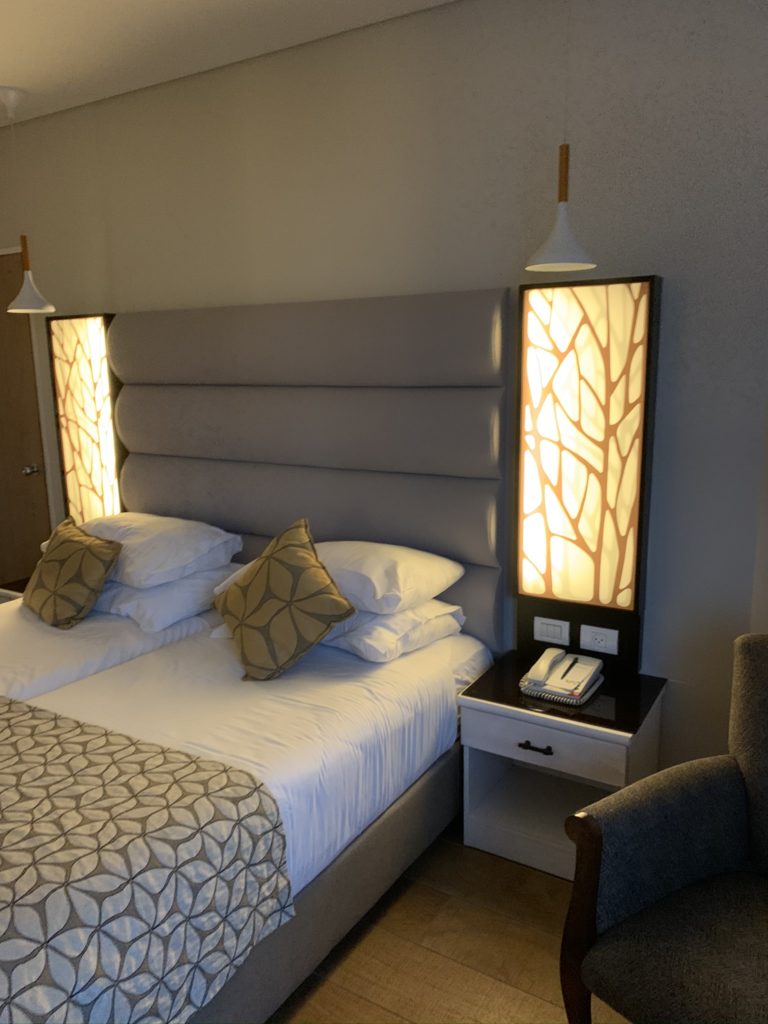
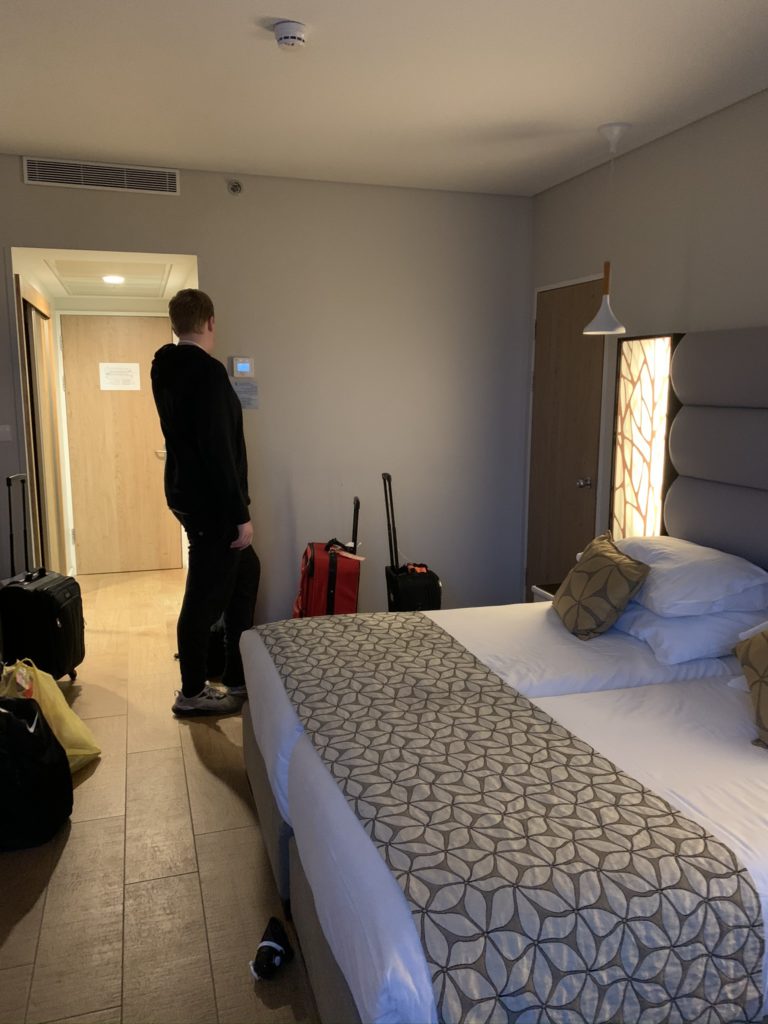
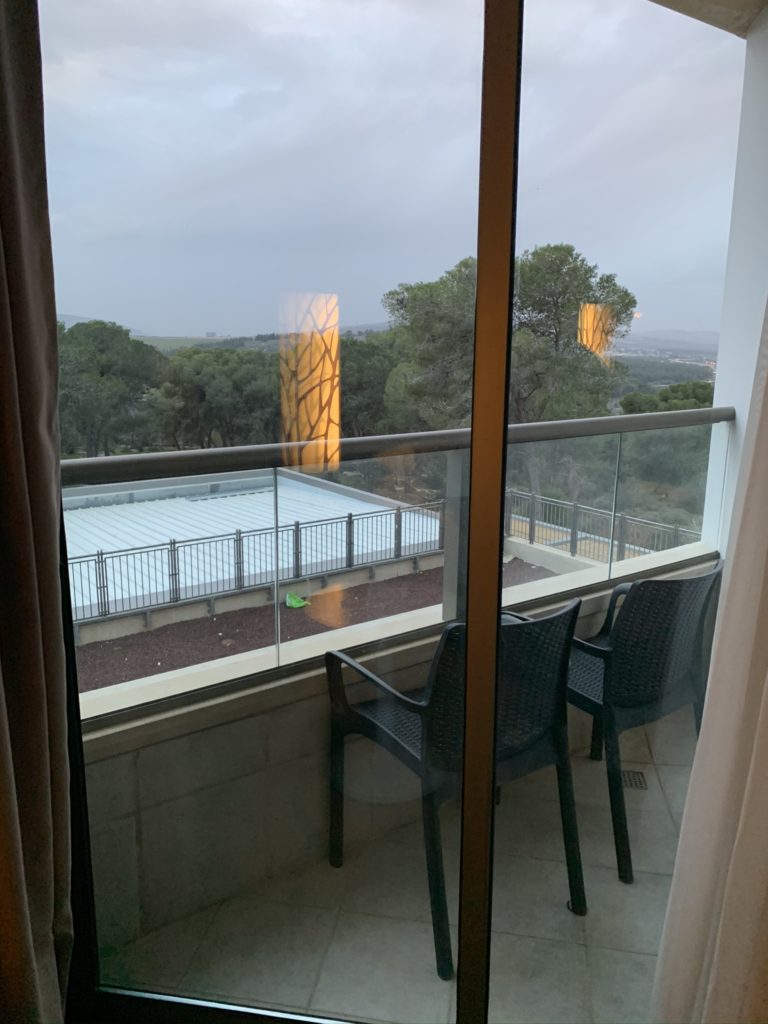
Tiny balcony, but an OK view.
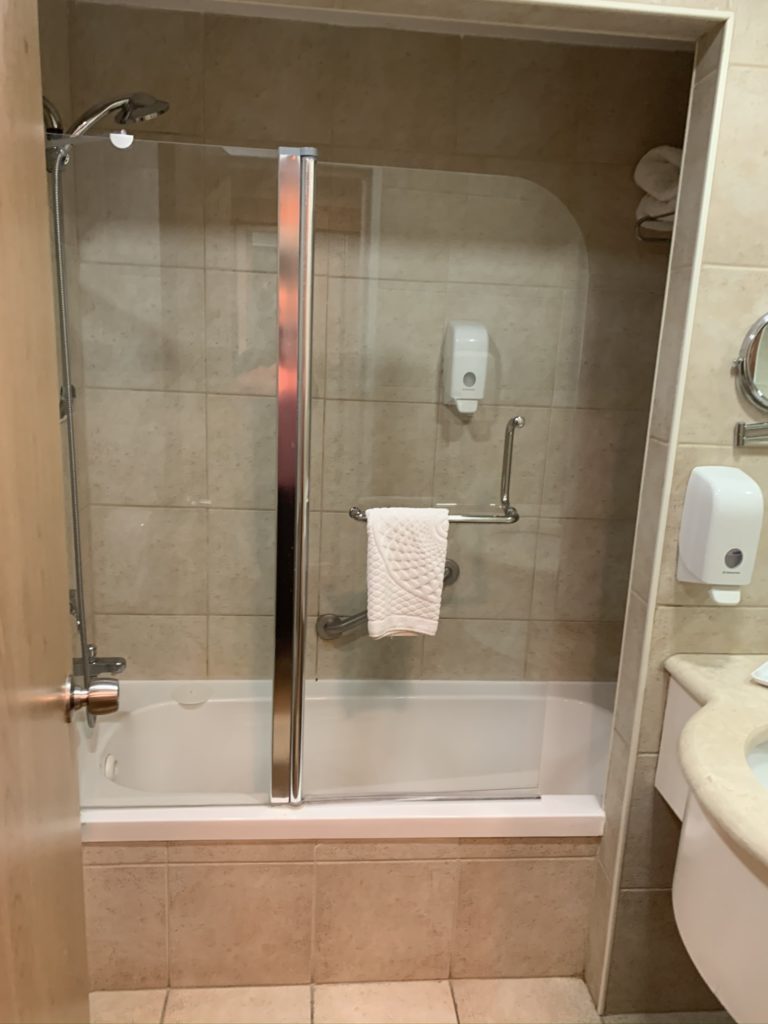
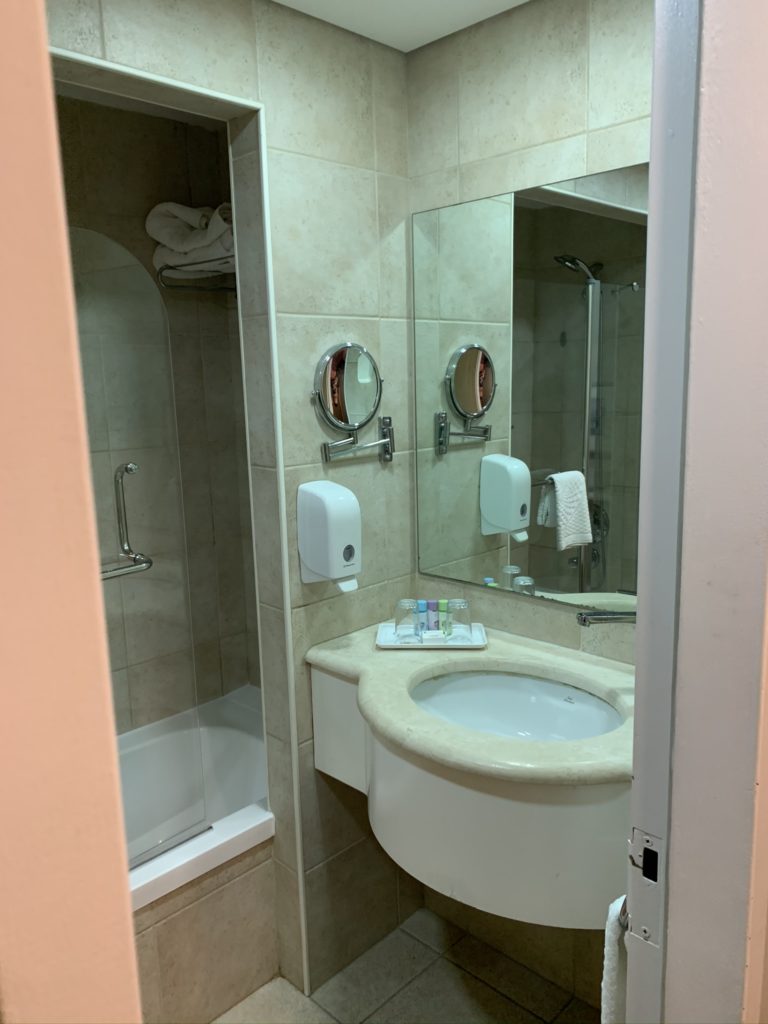
I had a picture in my mind of a place to stay at a kibbutz more like a youth hostel. Nope. Just like a hotel. Very nice dining hall, even if they did put us Gentiles in the corner. : )
A few other things from today I thought I would include. At Tel Dan we saw a scaly friend, which Evan was also enamored with…he was loving the animal creatures.
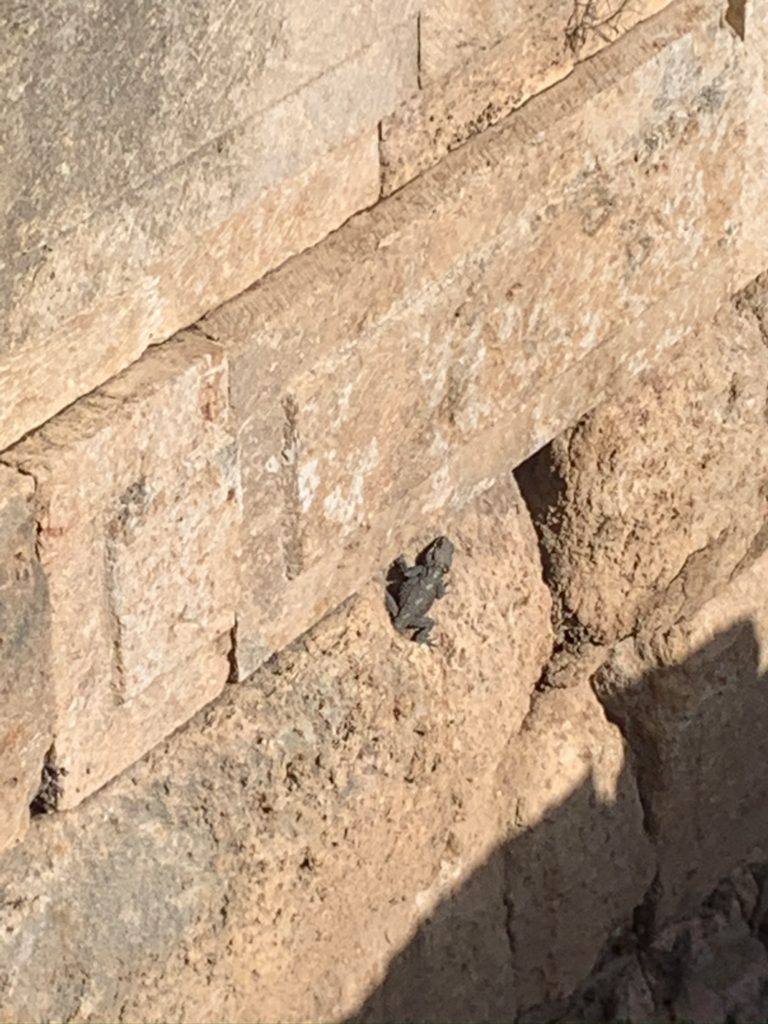
He was pretty cool, although unlike Evan, I did NOT want to hold him.
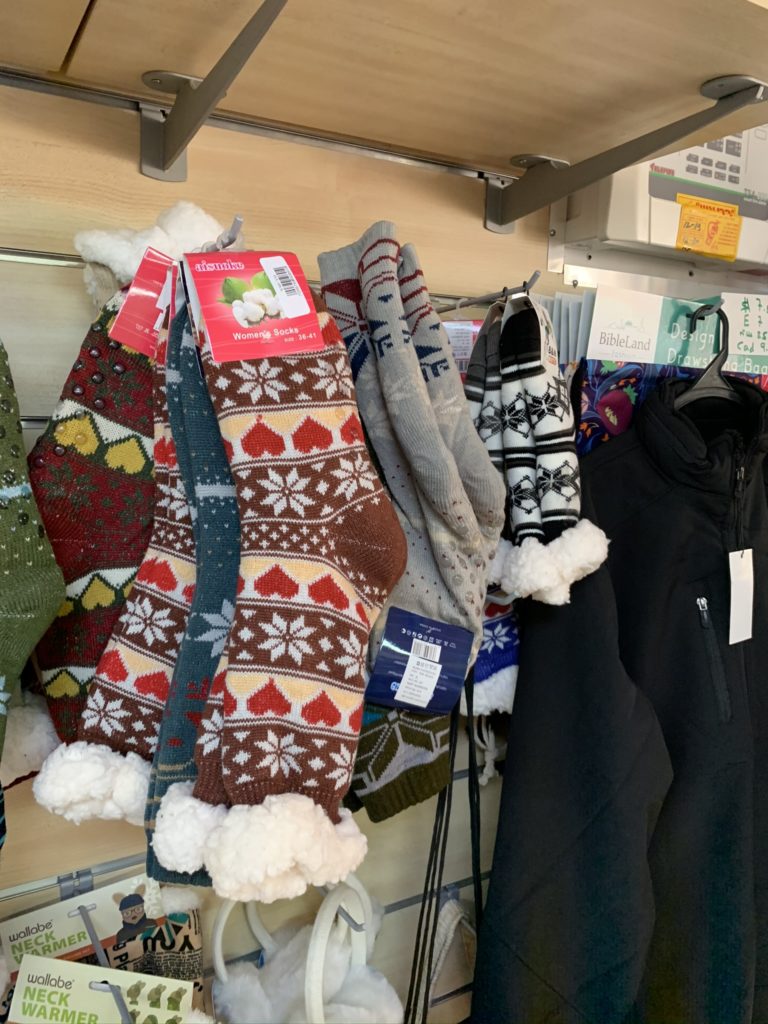
Those of you that know me well, know that I have a love for fuzzy socks. I am not the only one…these were in the gift shop at Caesarea Phillipi. They reminded me of a certain group that knows of my love of the fuzzy socks…you know who you are…
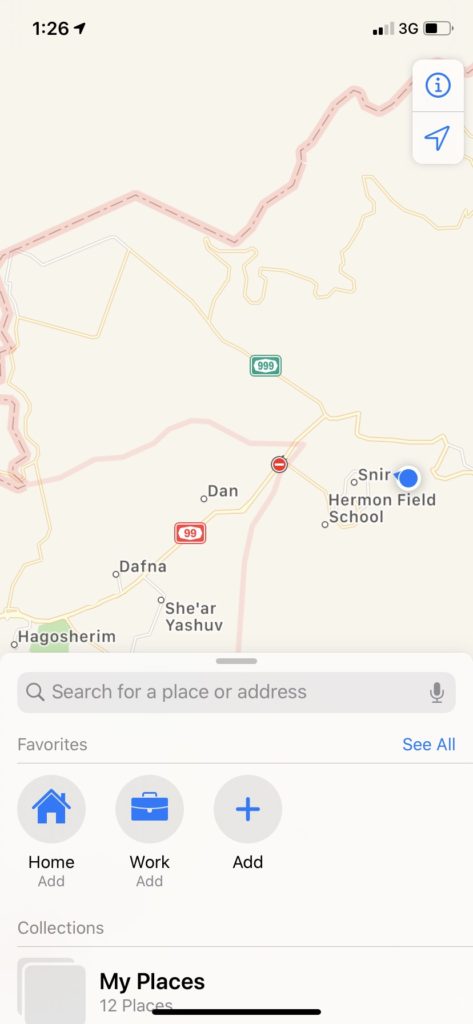
I also took a screen shot of my position on my map when we were hiking around Caesarea Phillipi. Awfully close to Syria and Lebanon way on up in the Golan Heights. Didn’t know that would happen! Glad we got to see it though.
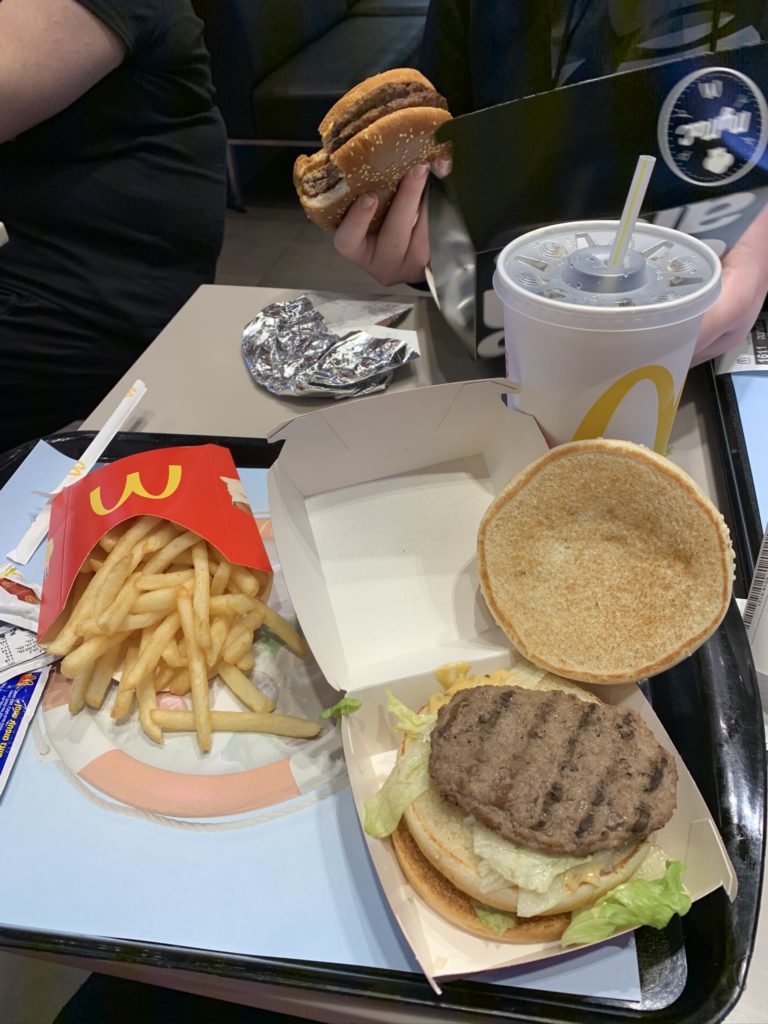
One of the highlights was also actually McDonalds. While not normally a favorite of mine, it was tasting really really good round about Day 10. There was no cheese on the Big Mac, they don’t do cheese with meat normally, but it was still really yummy. They have better burgers than we do. Evan got a huge burger.
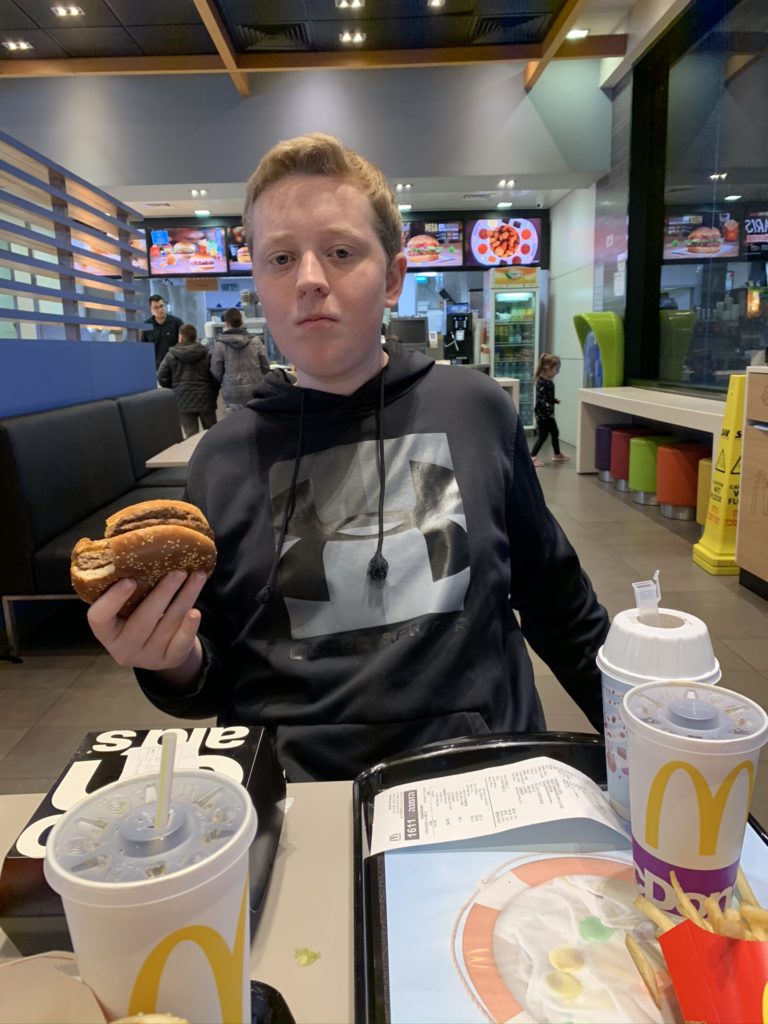
Another treat we were introduced to by both guides…a food that they said every 2 year old in Israel knows and loves…Bambas. The best way I can describe what they taste like is peanut butter flavored Cheetos. Oh ya, they’re good. We heard you can get them at Trader Joe’s. We’ll be needing to check that out, because they are darn tasty!
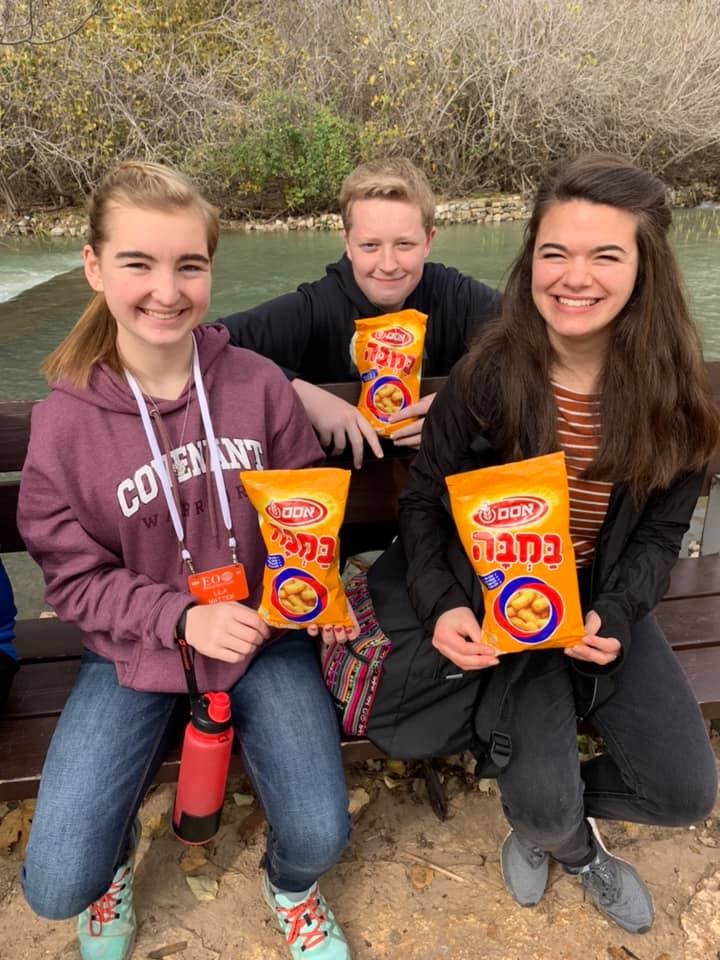
All the kiddos loved them, adults too!
OK, only two lengthy stops today, Tel Dan is first.
Jan 13, 2020 | Nancy’s Holy Land Trip 2019-20
Our guide for the hike extension, Eitan, had gone to live on a kibbutz when he turned 15. The one he went to is on the southern end of the Sea of Galilee, and we happened to drive right by it, so he took us for a tour. A kibbutz is a community that runs with socialist ideals. Everyone contributes what they have to the kibbutz, and whatever the people of the kibbutz need is drawn from the community pool. He said that this worked for some time, until members began to take advantage of it. Sounds like the over-arching difficulty socialism struggles with across the board. There are still operating kibbutzim in Israel, however; they are just run differently now. It was interesting to get a small glimpse into kibbutz life now.
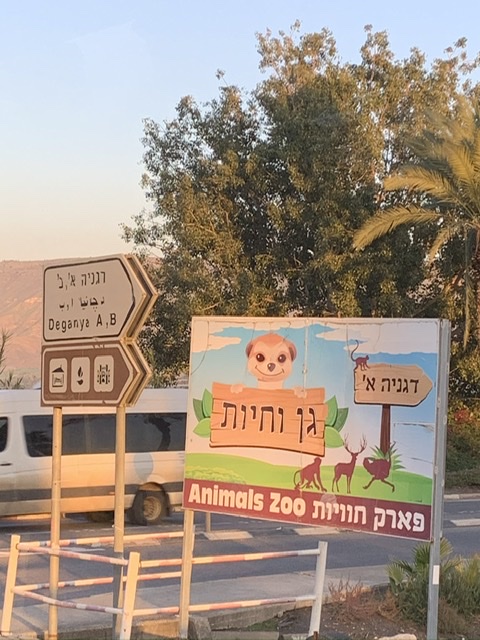
They apparently had a small animal zoo there, although we didn’t get to see it. They definitely had a large cattle operation that produces income for the community.
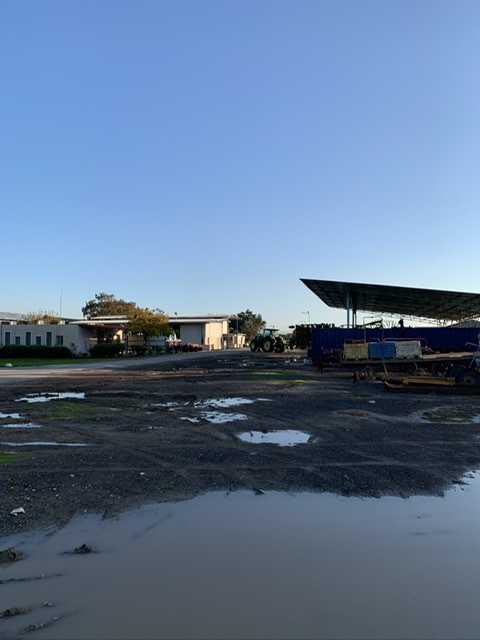
We got to see the school where all the kids go. Longer ago, the kids were taken from their homes to the community schools and daycares when they were very little and the parents didn’t see them much. Eitan said that has changed some now, and parents get to see their kids in the evenings now, and are allowed to make supper in their own dwellings now if they wish, instead of having supper in the community dining hall.
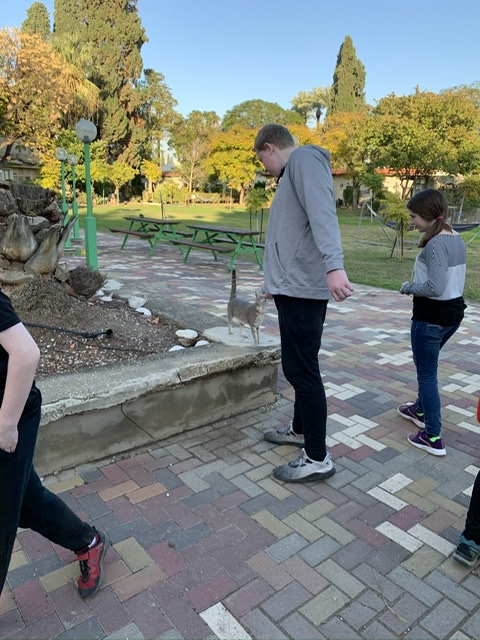
Evan the cat whisperer found a friend while we were there, of course. Then we walked by the hotel, a place where people can stay and a source of income for the kibbutz. In fact, our last two nights in Israel, we stayed at a different kibbutz.
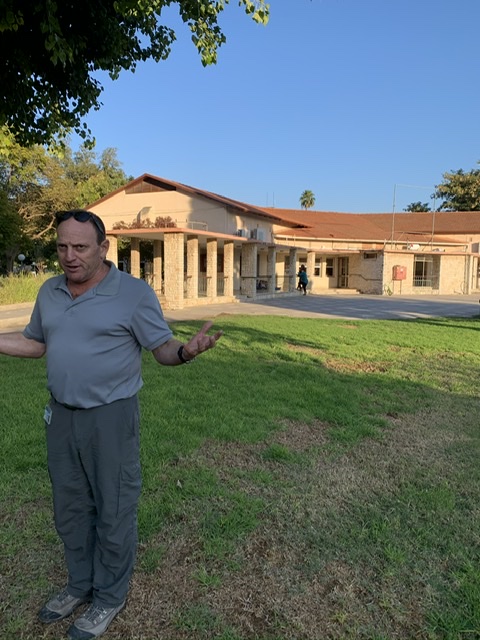
Here is Eitan describing the building behind him, the community center which included the dining hall and the place where the community’s “board” meets to make decisions regarding public matters, like whether or not it is OK to cut down a certain tree, or if someone will get funding to go to college.
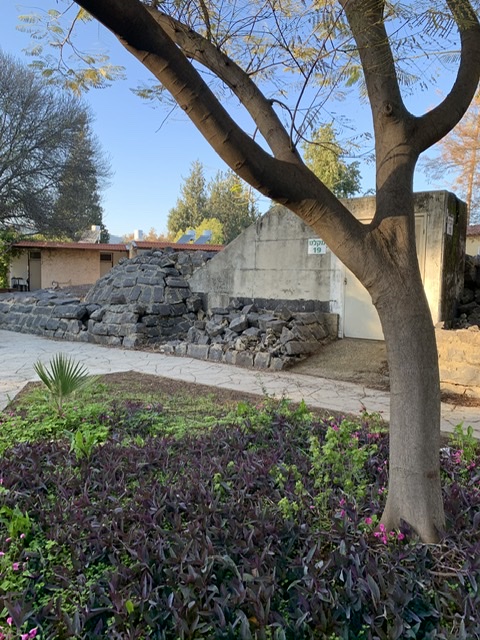
In the mid 1900s, this was a rather unstable area of the world, and they had multiple bomb shelters in case of air-raids. They are still usable, although the need to use them has not been there for several decades. Still…un-nerving a bit to have a bomb shelter in the middle of your community, just in case.
Upon leaving the kibbutz, Eitan showed us a chocolate shop near the bus. All the ingredients for the shop are produced by the kibbutz.
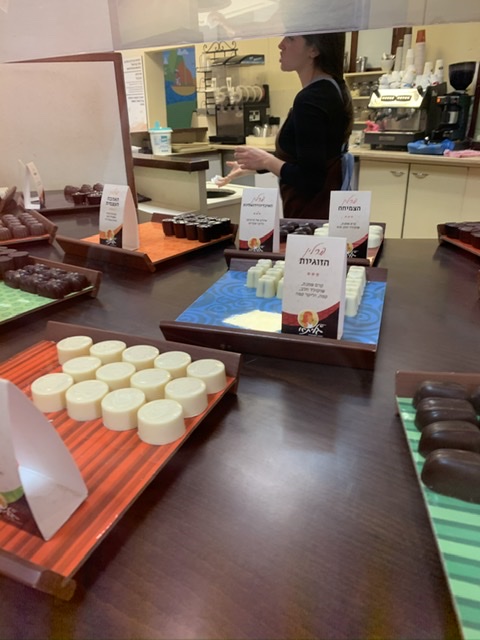
They had ice cream and specialty coffees as well. Neat place. On the way back to our hotel in Nazareth, we got a pretty spectacular sunset show.
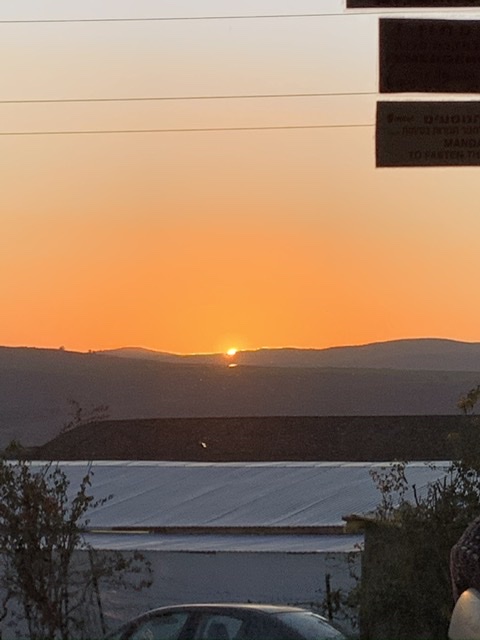
Nice cap to the day. Tomorrow we tackle Day 10!
Jan 13, 2020 | Nancy’s Holy Land Trip 2019-20, Uncategorized
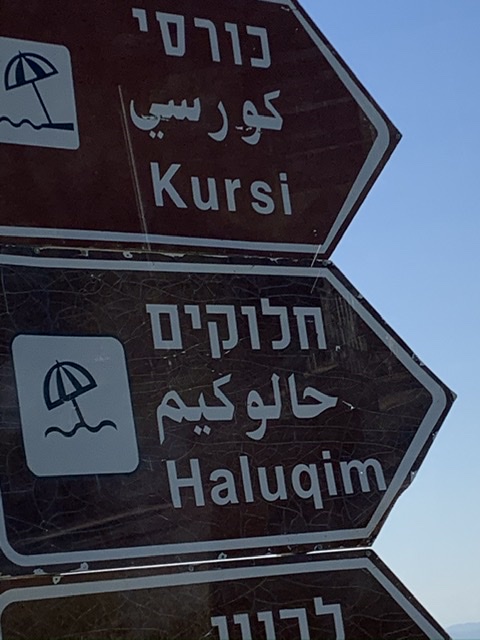
On the Northeast side of the Sea of Galilee, we are entering the area of the Golan Heights…where all the conflict was happening round about the 1990s, among other times. There are still mine field signs right by the road, so one doesn’t want to go wandering off on one’s own just there. Yikes!
This area is east of Capernaum, where Jesus began his ministry, where Peter’s house was, and the first church there, etc. This is the place were there were tombs that were roamed by the wretched refuse of society, like for instance the demon-possessed man. There were no chains that could hold him, and he was quite the public nuisance, so they banished him to this area on the northeast side of the Sea of Galilee. If a young archaeologist were inclined to search among the minefields of this area, perhaps remnants of the tombs would be found, but as it is, no one is going to go poking around up in these hills for the ancient burial sites that are indicated to be there by Scripture.
If you remember the story of the demon possessed man that Jesus healed from Mark 5:1-20, you might remember that the demons that were possessing him were many, and they called themselves “Legion.” Legion begged Jesus not to send them to the pit, and instead asked to be driven into a nearby herd of pigs which then ran off a cliff and were drowned. This is the area that this happened in. The exact hill is not known, but it is not hard to imagine this story when you see this landscape.
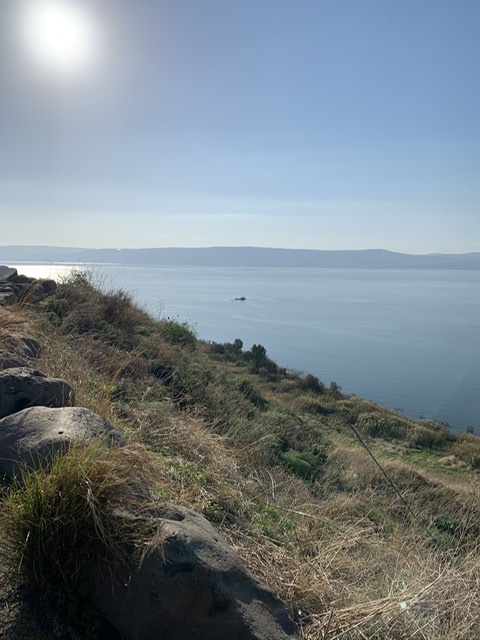
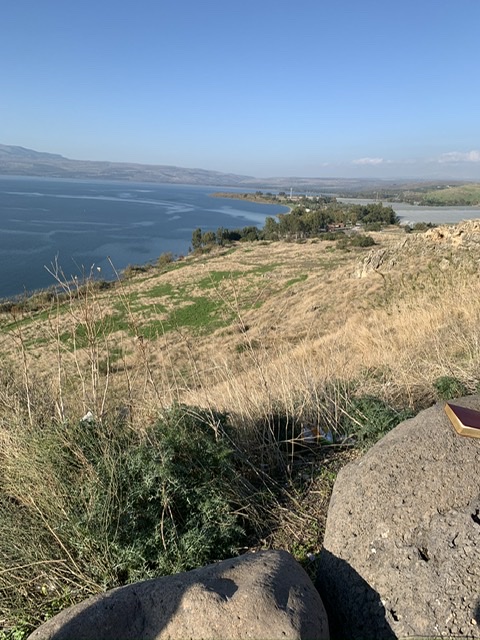
It is steep, and a drop-off straight to the water. The green grassy area at the bottom of this hill would have been underwater at the time of Jesus, as the water level is lower than usual now. Right by where we stopped to look over this cliff, there were the remnants of an old bunker used by snipers to shoot at local fisherman, nice, huh.
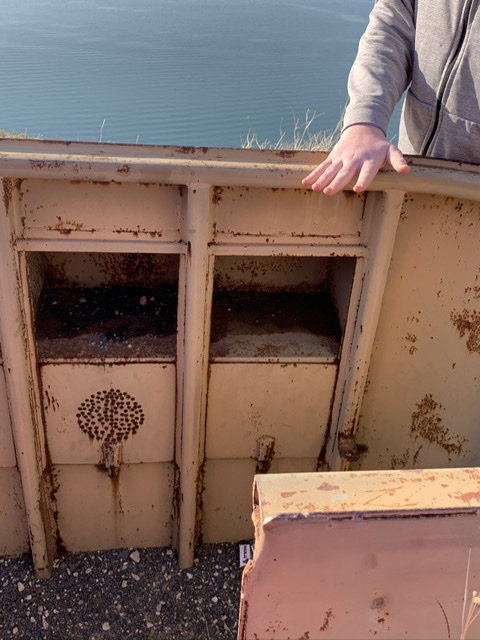
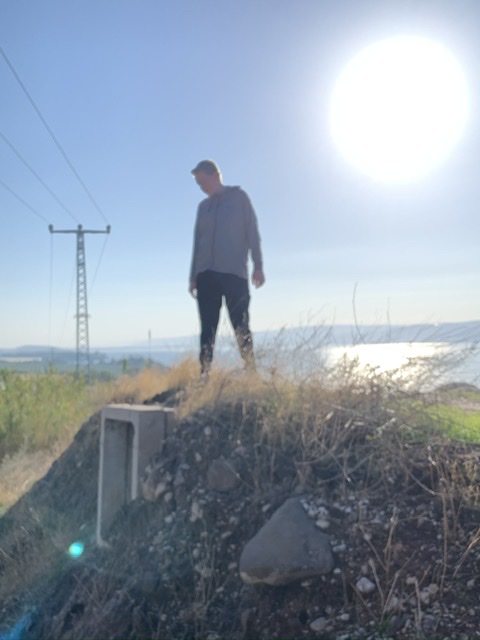
Here is Evan standing on top of the bunker.
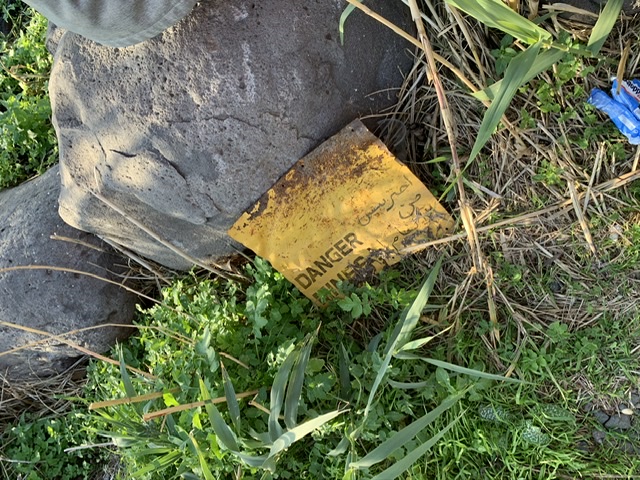
And there is your random land mine warning sign. This area was cleared as an overlook, but…you know…not something you see every day.
For some perspective, from this lookout on the eastern shores of the Sea of Galilee, we can see where we were this morning, Mt Arbel…the drop-off seen across the water.
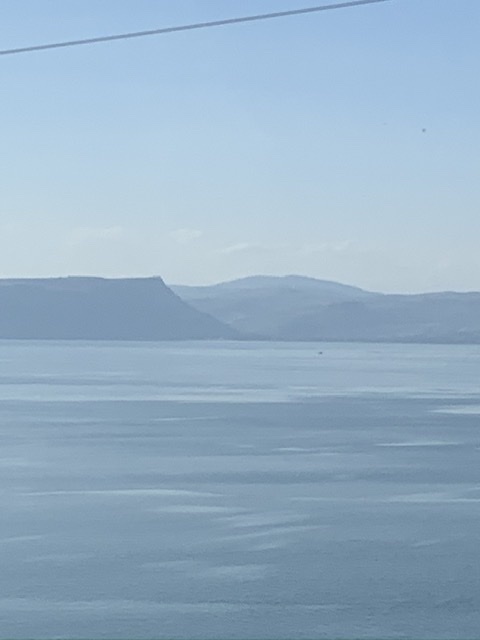
How pretty is that!
So to wrap it up for this site…Mark 5:20 speaks of the healed man telling his story in the Decapolis. The Decapolis is a collection of 10 cities of this region, all a part of the Roman Empire and ruled by Herod the Great, and then his sons: Herod Antipas, Phillip the Tetrarch, and Herod Archelaus. One of those cities of the Decapolis is Hippus or Sussita which is the area of Kursi, right where we were standing, and another is Bet She’an…you’ll hear more about that spot later…stay tuned!
Jan 13, 2020 | Nancy’s Holy Land Trip 2019-20
We get off the bus and enter the walkway down towards the Sea of Galilee…another site built right by the water.
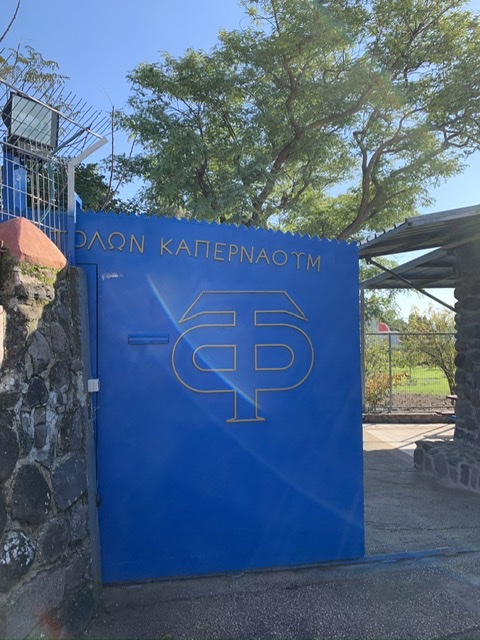 We are immediately greeted by peacocks and other migratory birds as we’re walking toward the spot where we will eat our box lunches picnic style.
We are immediately greeted by peacocks and other migratory birds as we’re walking toward the spot where we will eat our box lunches picnic style.
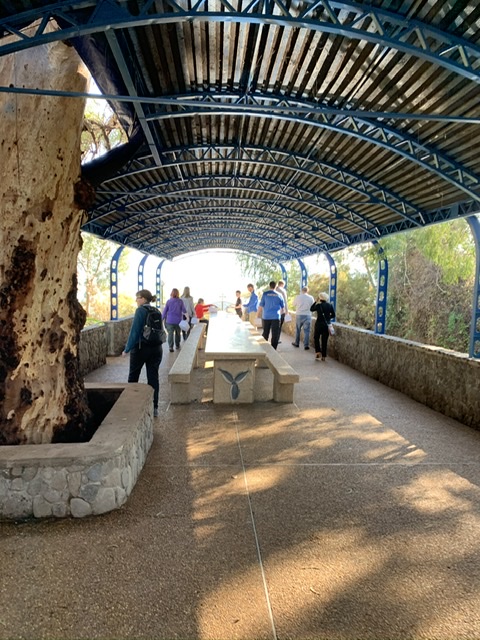 Of course, Evan and I aren’t as hungry as we were after the Pizza Hut yummies, but we enjoyed the scenery immensely and shared some of our tastier morsels with the local feline contingent. They were most grateful. All in all, a beautiful place for a picnic.
Of course, Evan and I aren’t as hungry as we were after the Pizza Hut yummies, but we enjoyed the scenery immensely and shared some of our tastier morsels with the local feline contingent. They were most grateful. All in all, a beautiful place for a picnic.
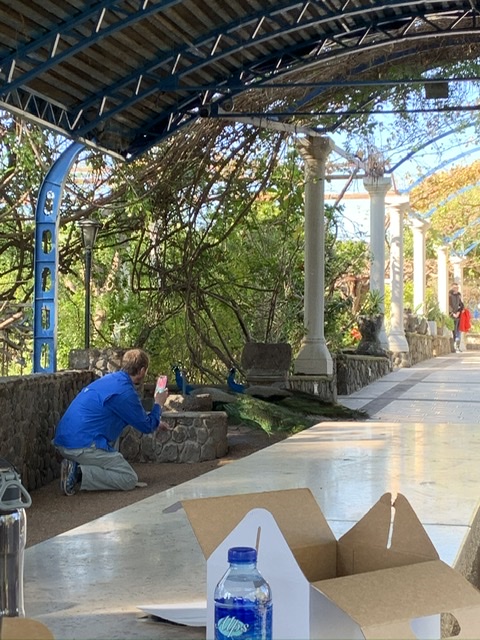
Pastor might have been trying to engage the peacocks…
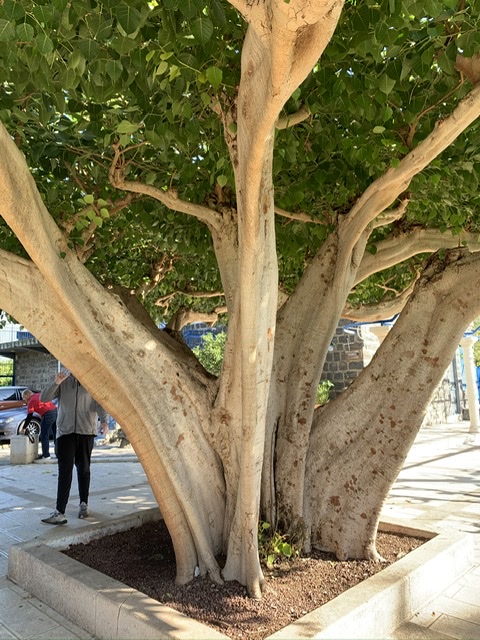
And check this out, like the biggest Ficus I’ve ever seen.
Then we walk this cool almost like tunnel of flora and fauna to the entrance of the Orthodox Church on the grounds here.
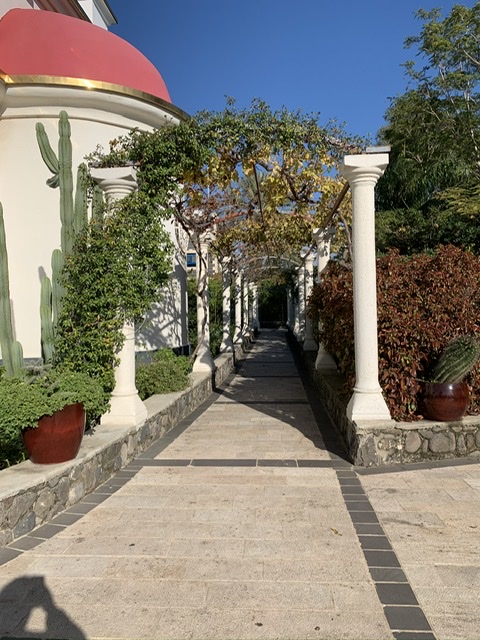 If you remember the last Orthodox Church we visited, they are characterized by artwork on every possible surface.
If you remember the last Orthodox Church we visited, they are characterized by artwork on every possible surface.
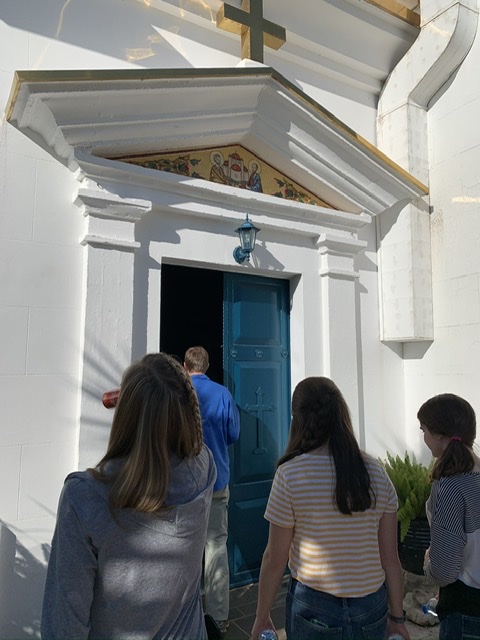
An entrance like this…opens into a room like this.
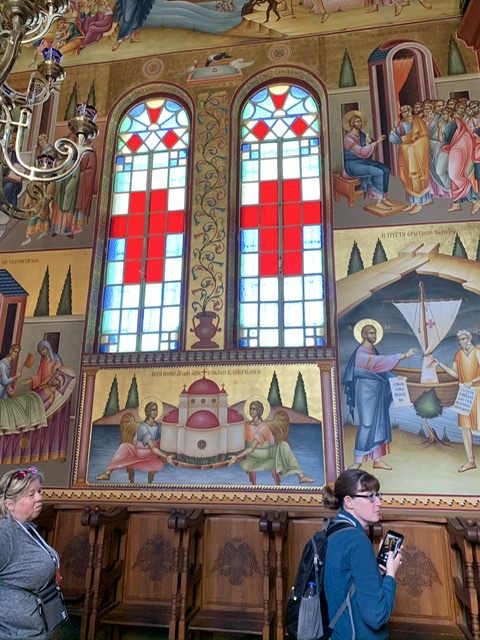
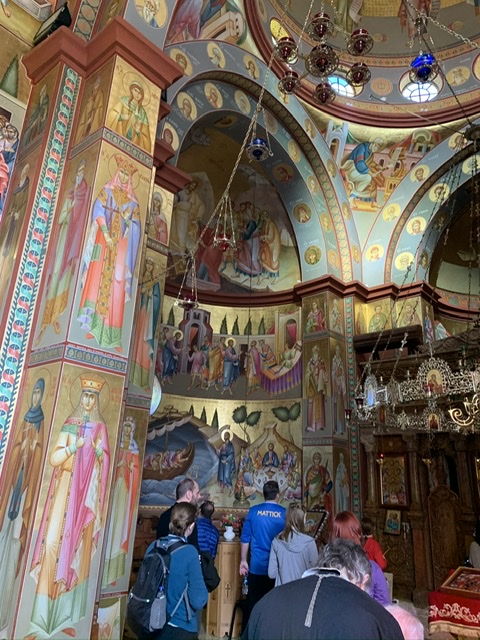
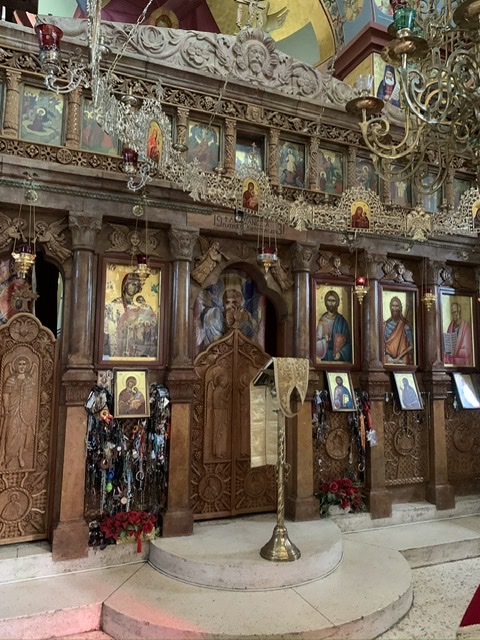
Eitan explained to us that on the wall that only the priest can enter, the first picture on the left will be Mary, the first picture on the right will be Jesus. The second picture on the right will be John the Baptist, and the second picture on the left will depict the person or group specifically being honored by this particular church. In this case, it was the 12 disciples. This church was a Russian Orthodox, which means they will speak Russian for the liturgy and it will be the same worldwide. Same for a Greek Orthodox. I didn’t know that.
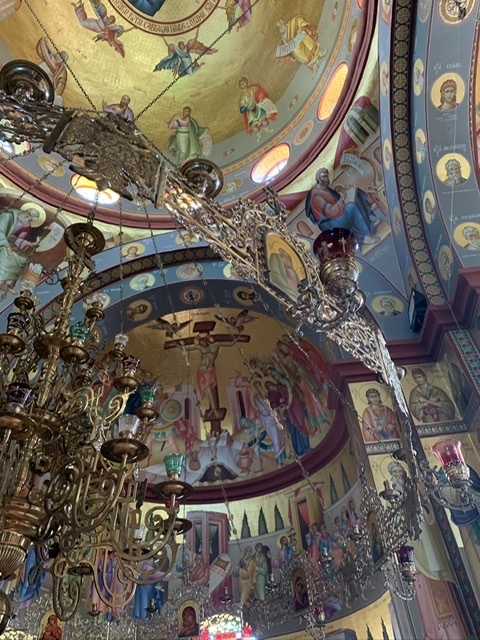
I was particularly intrigued by this story of satan depicted…
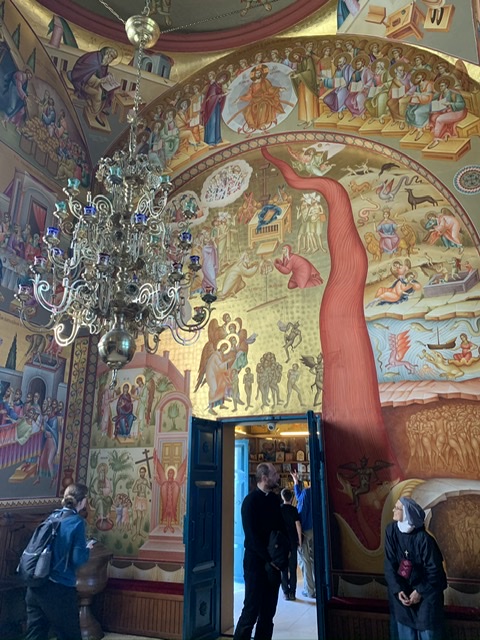
The red river flowed to hell (the part behind the nun). The part in the shadow of the door looked like this…
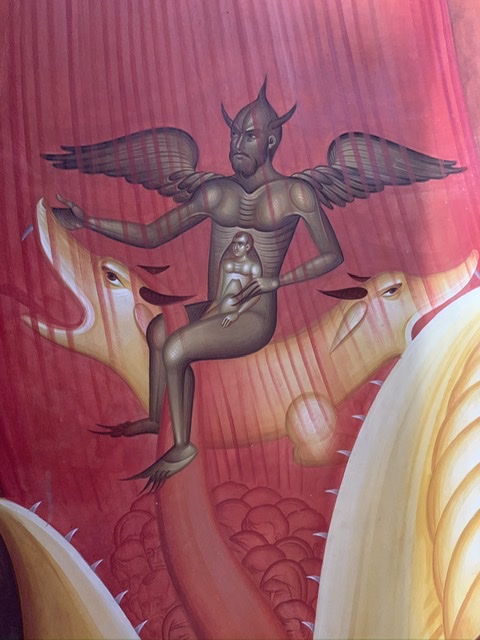
That is satan with Judas on his lap, about to be eaten. Very graphical story-telling. There was a man and what appeared to be his son in the church while we were there. Eventually, we were able to glean that he was actually receiving last rites. It was moving to see, but had we known what was happening, we would have gladly left them in peace for this. Still an active church, on such beautiful grounds.
Next up is a drive around the north end of the Sea of Galilee toward the Golan Heights near the Jordanian border. We would ultimately drive all the way around the Sea, but we were able to make a stop near Kursi. What happened here? Keep reading….
Jan 13, 2020 | Nancy’s Holy Land Trip 2019-20
I was surprised by just how moving this place was for me. When we were told where we were going, I thought it would be neat, but we really have seen a lot of ancient ruins by now, and they all look kinda the same. The story is what makes them so special. This place was different for me though. The ancient ruins we saw here, along with the story of course, were really special for me. Yes, I cried. I’m welling up just telling you all the story.
We pull up in the parking lot and get off the bus.
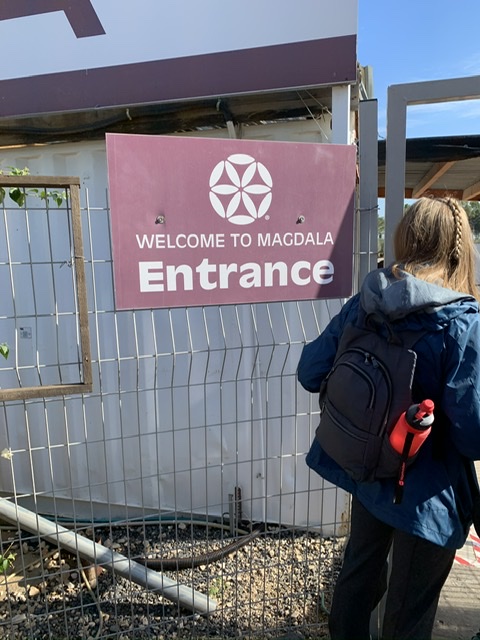 Eitan takes care of our entrance into the area, and we walk in and sit down on this big stair-step like seating area. This is a new place even for pastor, as this is a recent find. A builder wanted to build a hotel on the Sea of Galilee shores, and (nightmare for Israeli builders…) they run into ancient ruins. This means that the government will come in and just take the land away, halting building for archaeologists to assess what is there, and ultimately usually changing everything the builder had planned. It’s good for us though, because of what they found. The ancient city of Magdala, modern day Migdal, is really cool.
Eitan takes care of our entrance into the area, and we walk in and sit down on this big stair-step like seating area. This is a new place even for pastor, as this is a recent find. A builder wanted to build a hotel on the Sea of Galilee shores, and (nightmare for Israeli builders…) they run into ancient ruins. This means that the government will come in and just take the land away, halting building for archaeologists to assess what is there, and ultimately usually changing everything the builder had planned. It’s good for us though, because of what they found. The ancient city of Magdala, modern day Migdal, is really cool.
So we sit in the seating area facing none other than the ancient synagogue. In front of us there is a huge stone (replica) encased in glass. 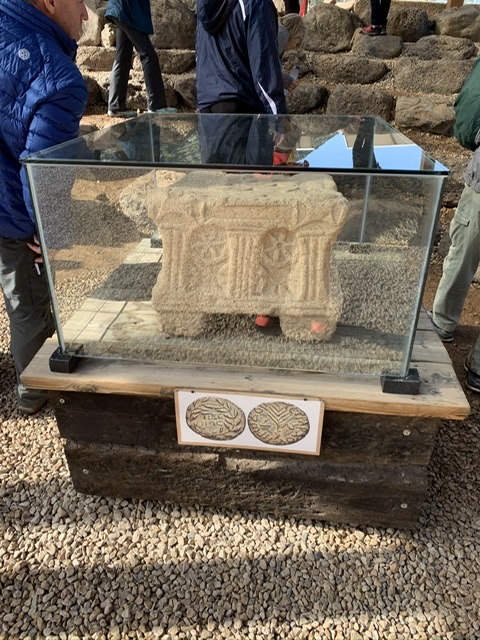
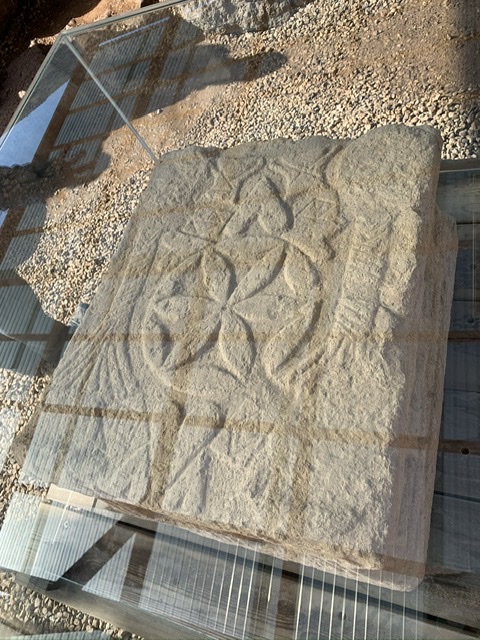
This is like the logo of Magdala.
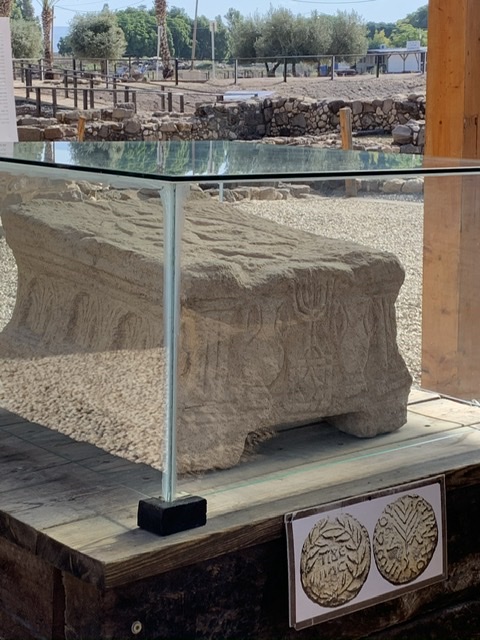
Check the menorah on the end. We know because of the three feet on the base that this is a picture of the menorah from the first temple…meaning, OLD. This is the teaching stone from the synagogue. In ancient times, the synagogue wasn’t a place of worship. It was more like a community center where people who traveled through the town could stop and teach and talk about other parts of the world and bring new ideas to a community. There was two rooms in this synagogue, one that could hold maybe 15-20 people, and another that could hold maybe 30 or so, with an open area with the teaching stone and seating around the edges. Check it out.
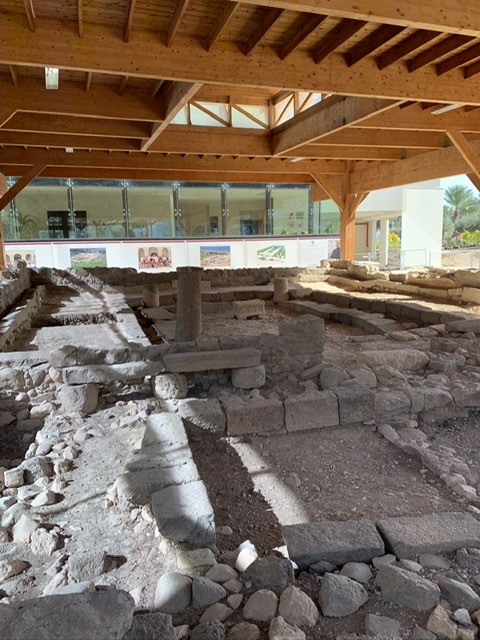 You can see the first smaller room closest to the camera, and the teaching stone in the further, larger room toward the back. The walls and all the seating here are original. The original teaching stone was taken to the Israeli museum. Our guide Eitan says that of all the places in the Holy Land, of all the historical and traditional places that things happened, that this is the place we can be most rest-assured that Jesus was, and where Jesus stood. He would have taught here, right by this teaching stone in the synagogue of Magdala, for sure. I can imagine Mary Magdalene hearing the new teaching coming from her synagogue, and the redemption she heard in His healing words. I was so moved here…see, it’s making me cry again. I can’t give any better explanation than that for the power this stop held for me.
You can see the first smaller room closest to the camera, and the teaching stone in the further, larger room toward the back. The walls and all the seating here are original. The original teaching stone was taken to the Israeli museum. Our guide Eitan says that of all the places in the Holy Land, of all the historical and traditional places that things happened, that this is the place we can be most rest-assured that Jesus was, and where Jesus stood. He would have taught here, right by this teaching stone in the synagogue of Magdala, for sure. I can imagine Mary Magdalene hearing the new teaching coming from her synagogue, and the redemption she heard in His healing words. I was so moved here…see, it’s making me cry again. I can’t give any better explanation than that for the power this stop held for me.
Another thing that I thought was kinda cool. There are many anti-bird tactics being used to keep birds out of the synagogue area for obvious reasons. These birds were not deterred.
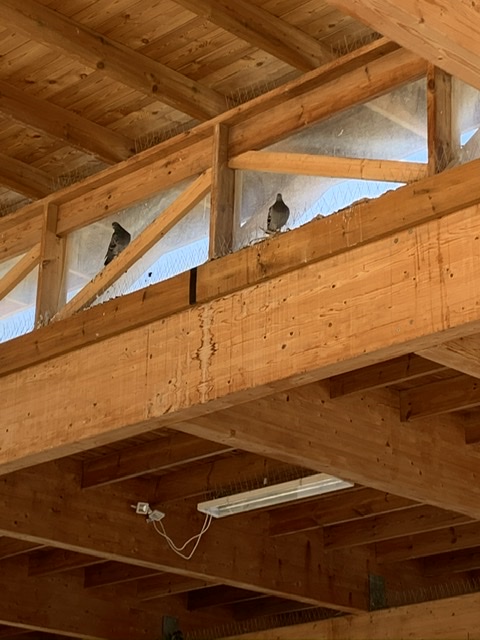
You can kinda see all the little pins up there to keep them from landing. And here too.
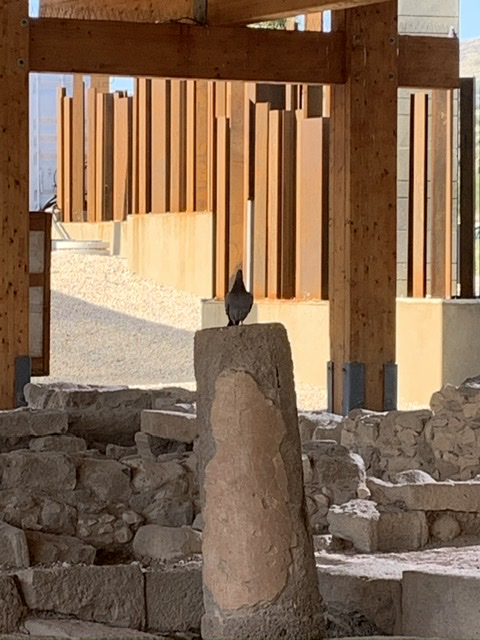
They were right above and beside the teaching stone. It’s so funny, because that was the only place there was birds, like they wanted to be close to Jesus’ spot! I’d want to be close to Jesus too! Silly, but I thought it was interesting anyway.
On the other side of the synagogue was a Main Street with shops. One of the shops was a fish salting market. After all, Magdala was a fishing town right on the Sea of Galilee. There were small bowl-like ruins found out front of the store, to show what was for sale.
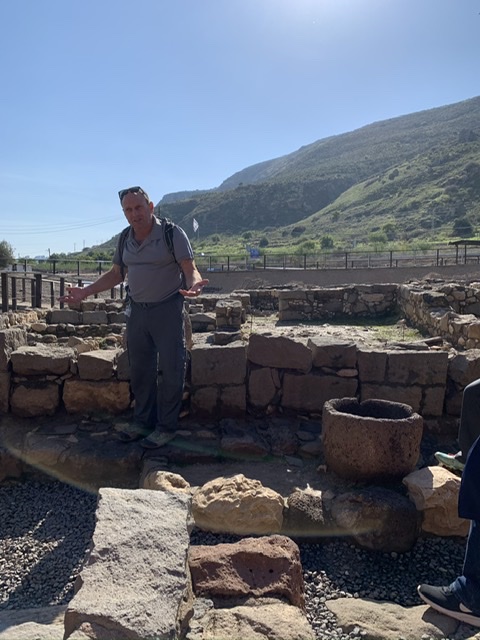
And there were bigger holding tank-like troughs inside the store.
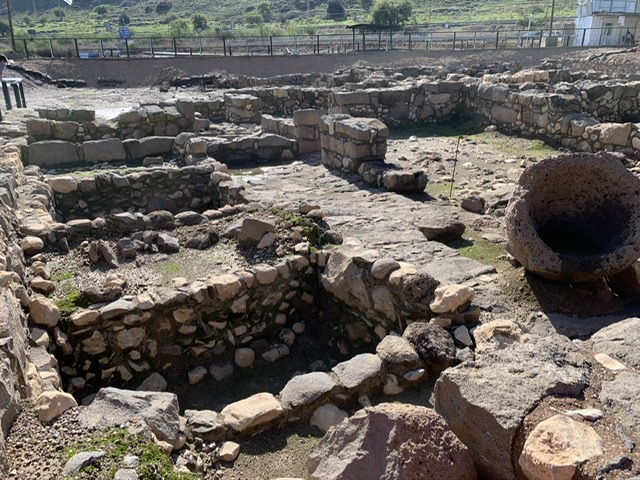
Very cool to see this aspect of the lives of those who lived here then.
Back behind the ruins was built, of course, a church. Since this is a modern find, it is a modern church…and beautiful in it’s own way.
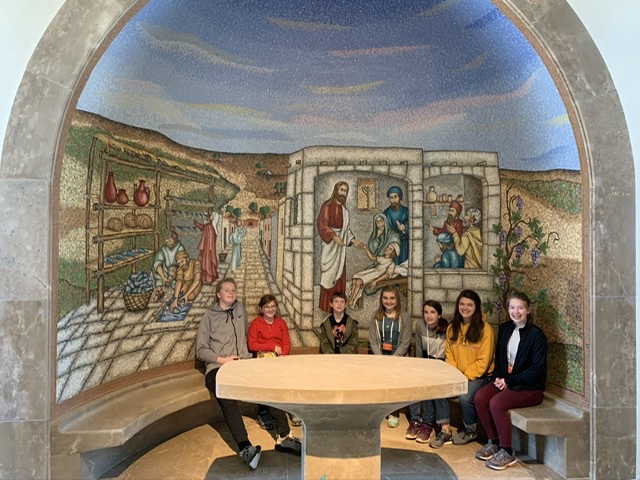
There are 4 small chapels on the main floor, each with it’s own mosaic depiction of a bible story. Here is the healing of Jairus’s daughter, that happened just down the road in Capernaum. Connecting the 4 chapels was one large foyer kind of area with a fount in it.
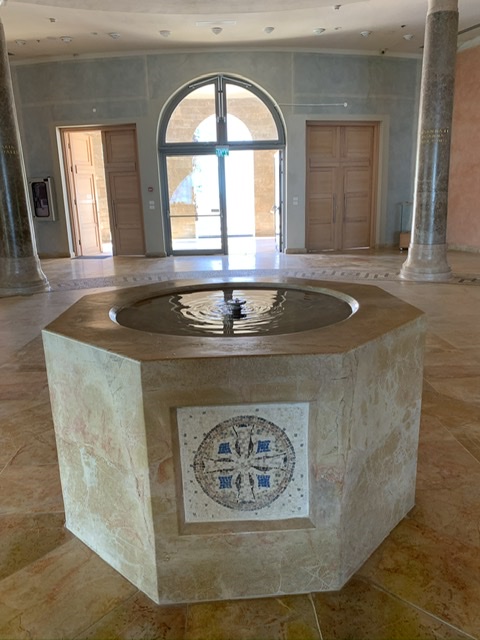
You can see a couple of pillars in this picture. There were 6 of these pillars, 5 of which had the names of important women in Jesus life, like, of course, Mary Magdalene. 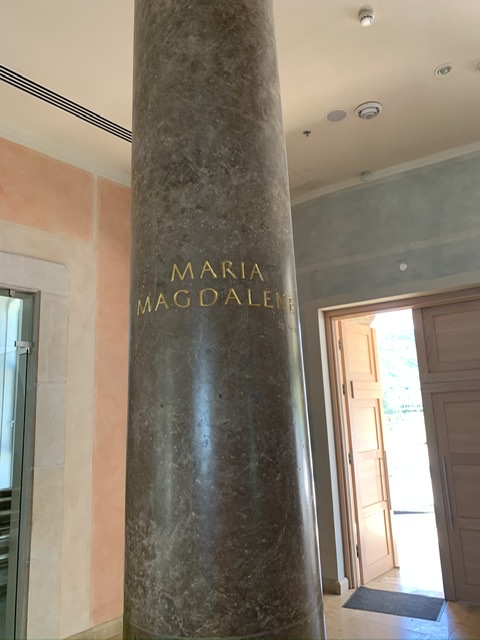
One of the pillars was blank. Our guide Eitan explained that this is for all women, who are so important to Jesus. Reminds me of a chapter of a book I read called “Jesus Through Middle Eastern Eyes” that talks about how much Jesus cared for and provided for women in His life and in His Word. Well, ya, of course I cried…you’re getting the theme here, right?
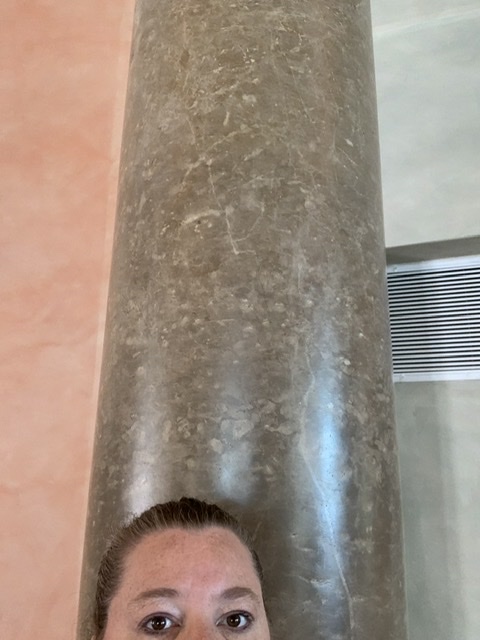
Here’s me with my pillar. : )
On the other end of the foyer was a beautiful sanctuary.
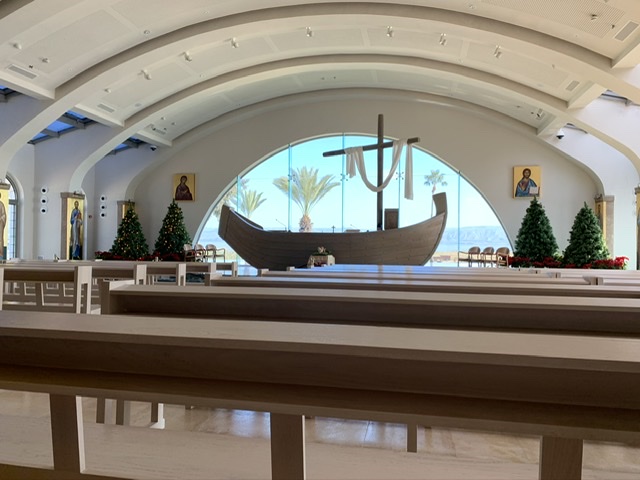
Behind the boat was a pool, what do you call that when the edge of the pool is not visible….zero-something. Right behind it is the Sea of Galilee. So so so beautiful. On the walls were paintings of each of the 12 disciples. Interesting to see how they portrayed Judas compared to the others.
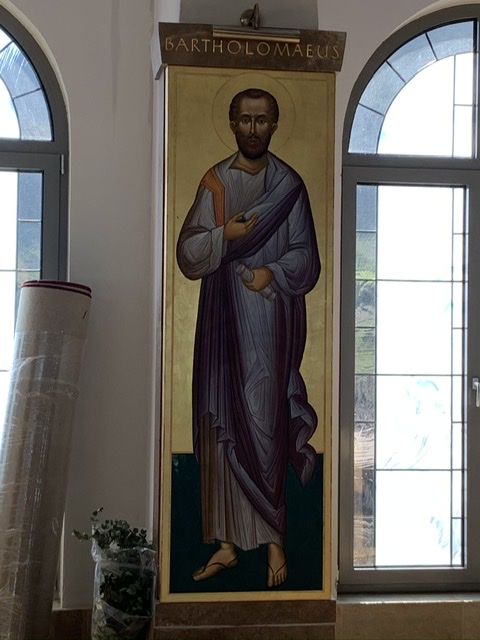
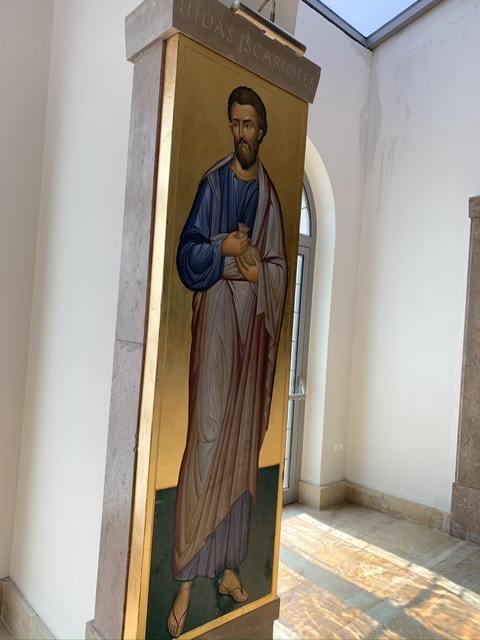
No halo, looking down and forlorn, and carrying his 30 pieces of silver.
In the basement of this space was another worship area, modern and beautiful, with the nicest bathrooms we saw all trip, by the way. Check out this backdrop.
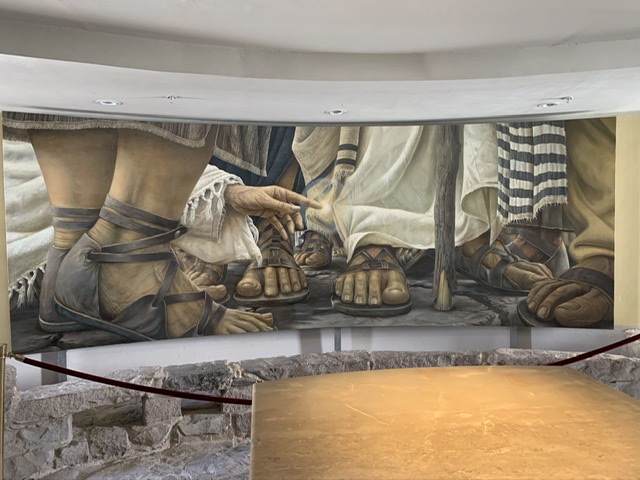
The story of the woman who touched Jesus garment for healing. This mural was taller than a person and a eighth of the way around a circular room. Very cool.
That pretty much sums up our excursion into Ancient Magdala. Did you like it? Mmm. One of my favorites for sure. After we left here, we did the supermarket and Pizza Hut, and then headed down the road to Orthodox Capernaum.









































 We are immediately greeted by peacocks and other migratory birds as we’re walking toward the spot where we will eat our box lunches picnic style.
We are immediately greeted by peacocks and other migratory birds as we’re walking toward the spot where we will eat our box lunches picnic style. Of course, Evan and I aren’t as hungry as we were after the Pizza Hut yummies, but we enjoyed the scenery immensely and shared some of our tastier morsels with the local feline contingent. They were most grateful. All in all, a beautiful place for a picnic.
Of course, Evan and I aren’t as hungry as we were after the Pizza Hut yummies, but we enjoyed the scenery immensely and shared some of our tastier morsels with the local feline contingent. They were most grateful. All in all, a beautiful place for a picnic.

 If you remember the last Orthodox Church we visited, they are characterized by artwork on every possible surface.
If you remember the last Orthodox Church we visited, they are characterized by artwork on every possible surface.






 Eitan takes care of our entrance into the area, and we walk in and sit down on this big stair-step like seating area. This is a new place even for pastor, as this is a recent find. A builder wanted to build a hotel on the Sea of Galilee shores, and (nightmare for Israeli builders…) they run into ancient ruins. This means that the government will come in and just take the land away, halting building for archaeologists to assess what is there, and ultimately usually changing everything the builder had planned. It’s good for us though, because of what they found. The ancient city of Magdala, modern day Migdal, is really cool.
Eitan takes care of our entrance into the area, and we walk in and sit down on this big stair-step like seating area. This is a new place even for pastor, as this is a recent find. A builder wanted to build a hotel on the Sea of Galilee shores, and (nightmare for Israeli builders…) they run into ancient ruins. This means that the government will come in and just take the land away, halting building for archaeologists to assess what is there, and ultimately usually changing everything the builder had planned. It’s good for us though, because of what they found. The ancient city of Magdala, modern day Migdal, is really cool.


 You can see the first smaller room closest to the camera, and the teaching stone in the further, larger room toward the back. The walls and all the seating here are original. The original teaching stone was taken to the Israeli museum. Our guide Eitan says that of all the places in the Holy Land, of all the historical and traditional places that things happened, that this is the place we can be most rest-assured that Jesus was, and where Jesus stood. He would have taught here, right by this teaching stone in the synagogue of Magdala, for sure. I can imagine Mary Magdalene hearing the new teaching coming from her synagogue, and the redemption she heard in His healing words. I was so moved here…see, it’s making me cry again. I can’t give any better explanation than that for the power this stop held for me.
You can see the first smaller room closest to the camera, and the teaching stone in the further, larger room toward the back. The walls and all the seating here are original. The original teaching stone was taken to the Israeli museum. Our guide Eitan says that of all the places in the Holy Land, of all the historical and traditional places that things happened, that this is the place we can be most rest-assured that Jesus was, and where Jesus stood. He would have taught here, right by this teaching stone in the synagogue of Magdala, for sure. I can imagine Mary Magdalene hearing the new teaching coming from her synagogue, and the redemption she heard in His healing words. I was so moved here…see, it’s making me cry again. I can’t give any better explanation than that for the power this stop held for me.










